Hi again. This is the final part of our ESR Teugen Hausen refight. Last post we left the French (Friant's division to be precise) in control of the heights opposite Hausen with St Hilaire's division deploying to their rear. At the Austrian end, Lusignan's division was badly mauled and routed entirely with so much accumulated fatigue that it wasn't even worth rallying. So Austrian command resolved to let it go without even attempting some sort of recovery. At this point we carried on........
The next two moves are used by both sides to dress their ranks, deploy artillery and generally glare each other down. It is now early afternoon.
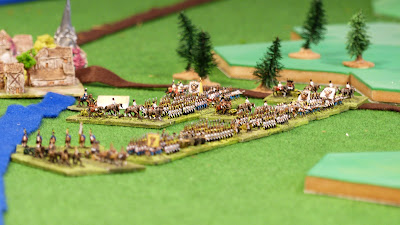 |
| Saint Julien's division is now deployed but some awful command rolls mean that he is unable to deploy all his artillery at once. |
 |
| Opposite Saint Julien and occupying the high ground, Friant's troops reorganise their line after kicking Lusignan's troops off the hill. |
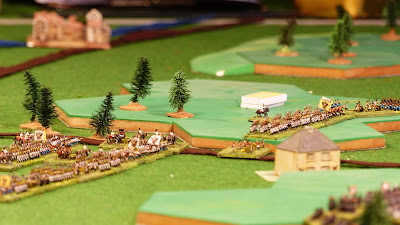 |
| The entire Austrian defensive line. Saint Julien on left, Vukassovich with the Advance Guard on the hill at right |
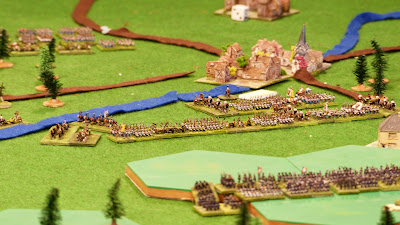 |
| The view from behind French lines |
|
At this point Vukassovich received orders to engage St Hilaire's division opposite him. Saint Hilaire was still partly deployed with more than half his division still in march column and the Austrian intent was to catch him unawares. Moreover with the French division partly deployed there was a greater possibility of success for the numerically inferior Austrians.
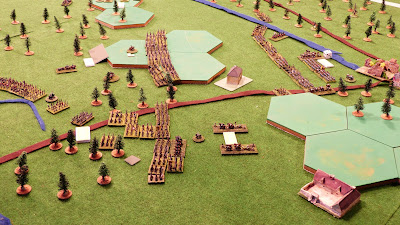 |
| Vukassovich launches his attack (foreground) |
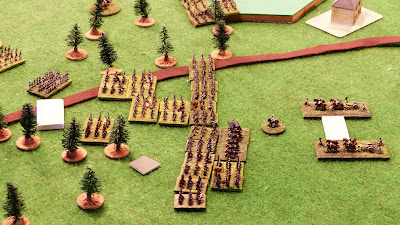 |
| The local situation up close. The presence of cavalry (centre) in the attacking division negates superior French skirmishers and allows the Austrians to advance without fear of the French voltigeurs and tirailleurs |
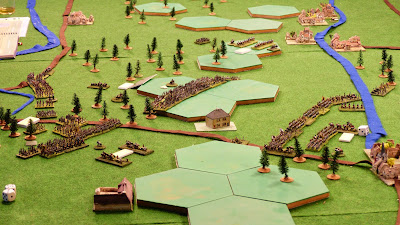 |
| The attacking division (left) from behind Austrian lines |
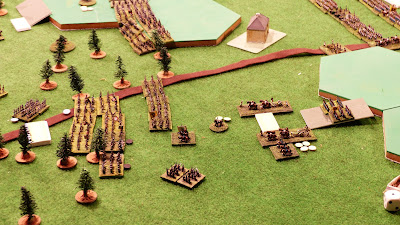 |
| The attack however fails to make any headway and falters |
 |
| Although a few French units are forced to retire in confusion, all Austrian units are eventually repulsed (right) |
On the other side of the table, Rosenborg receives his marching orders to move to the aid of Hohenzollern, His troops move out from around Dunzling.
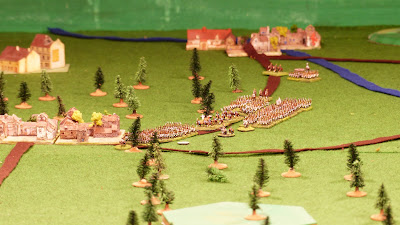 |
| Rosenborg's column finally lurches forward |
|
|
| |
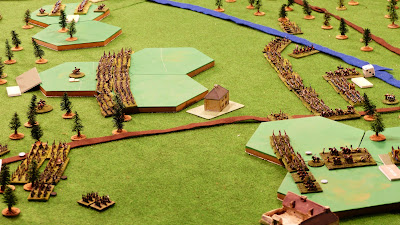 |
| Vukassovich fails his Assessment (morale) check and accumulates even more fatigue, forcing him to break contact and retreat (bottom, right). It is now looking decisively grim for the Austrians. |
At this point we made some quick calculations. Rosenborg was at least an hour's march away and needed at least yet another hour to deploy. Furthermore, according to the scenario instructions it would be at least an hour before the Austrian side became eligible to call up two elite grenadier divisions which were held off table in reserve. Allowing for a quick successful call (improbable) for reinforcements, the grenadiers would need another hour at least to march to the front and deploy. Therefore the French had well in excess of two hours (six moves) before possibly being threatened to the rear by Rosenborg and to the front by any potential reinforcements. In those two hours Saint Julien's division was practically alone to face the entire French force.
So it became very clear that the French would easily sweep through the weakened Austrians to their front and deal with either Rosenborg or the reinforcements (assuming they arrived) piecemeal.
Clearly the result would be a foregone conclusion so we decided there was no point in continuing. The wide split in the Austrian army and the considerable distance between the two corps proved their downfall and the French would easily brush aside all resistance and march to safety.
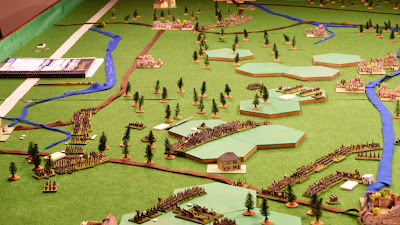 |
| The final positions. Rosenborg's columns can be seen in the far distance and would need at least another couple of game hours to arrive and deploy. In foreground all that is left to face the French is Vukassovich's very weakened division (bottom left) and Saint Julien (bottom right). The French have more local numbers and better quality troops so the eventual result was never in doubt. |
I am still very much undecided about ESR to be honest. Ideologically, they are a fine set of rules but I find them to be very economical with the detail and clarifications necessary to play the game without having to interpret many situations. It is true that there are many examples of play contained in the rulebook but they can hardly cover all situations. Sometimes a well-placed phrase or sentence goes miles to give a clearer picture of the game mechanics. I also find that limiting artillery range to 900 yards whereas an infantry unit moves 1125 yards in one move means that most infantry will keep out of range and advance to contact in one move without suffering any bombardment on their approach - once in contact they will take one round of artillery and skirmish fire plus close range fire during the combat phase (canister fire is integrated in an artillery battery's Combat Rating). Having said that however, I still think they are a very good ruleset which could have been excellent had there been a little bit more attention to explain that little bit more clearly.
This will probably be my last post for this first year of my blog. I must say I am enjoying posting and thank you all for taking the time to visit. A Merry Christmas to you all and a very Happy New Year, of course. Happy gaming and hope to see you all visiting once more in 2019!
